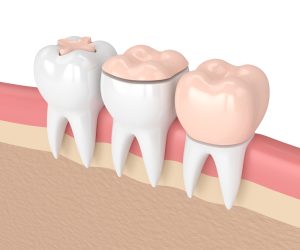

Which Restoration Is Best for You?
When facing dental decay or damage, understanding your restorative options can feel like you’re deciphering a complex medical textbook. In this comprehensive guide, we’ll discuss dental restorations and break down the differences between dental crowns, inlays, and onlays. Our Staten Island dentists seek to make these decisions easier by providing clear comparisons that empower you to choose the right solution for your pearly whites.
Dental Crowns, Inlays, and Onlays
When it comes to restorative dentistry, several options exist that address dental issues and restore the health and functionality of patients’ teeth. Among these options are dental crowns, inlays, and onlays. Each of these restorations serves a unique purpose based on the severity of the dental problem.
What Are Dental Crowns?
Dental crowns act as a replacement for the entire tooth structure above the gum line. When a tooth is severely damaged or weakened due to issues like extensive decay, cracks, or fractures, a crown provides an ideal solution. They effectively “cap” or cover the remaining underlying tooth after removing the decay and repairing damage.
A dental crown not only restores strength to the affected tooth but also enhances its aesthetics, allowing it to blend seamlessly with the natural teeth. These restorations can be crafted from various materials such as porcelain-fused-to-metal (PFM), all-ceramic, zirconia, or gold, catering to individual preferences.
Imagine a scenario where a patient has a severely decayed tooth that can’t be repaired with traditional fillings. In such cases, a dental crown can provide long-lasting durability and protection for the compromised tooth. This restoration option ensures that chewing forces are distributed evenly across adjacent teeth while maintaining aesthetics.
What Are Inlays and Onlays?
Inlays and onlays are types of dental restorations used to repair decayed or damaged teeth, especially when the damage is too extensive for a dental filling but not extensive enough to require a full dental crown. They’re often used to restore molars and premolars. Both inlays and onlays are typically made from durable materials like porcelain, composite resin, or gold.
Inlays
- Location: An inlay fits within the cusps (or bumps) on the chewing surface of a tooth.
- Use: They’re used when the decay or damage is between the cusps of a tooth but doesn’t affect the overall structure of the tooth’s crown.
- Procedure: After the decayed portion of the tooth is removed, an impression or digital scan of the tooth is taken. The inlay is fabricated in a dental lab and cemented or bonded to the tooth during a subsequent visit.
Onlays
- Location: An onlay is more extensive and covers one or more cusps or even the entire biting surface of the tooth.
- Use: They’re used when the damage extends beyond one or more cusps but still doesn’t require a full crown.
- Procedure: The procedure for an onlay is similar to that of an inlay. The decayed or damaged portion is removed, an impression or scan is taken, and the onlay is fabricated in a dental lab. It’s then cemented or bonded to the tooth during a subsequent visit.
 The Application Processes
The Application Processes
There are notable differences between dental crowns and inlays/onlays when it comes to the application processes. While both procedures restore damaged teeth, the extent of tooth preparation and the number of dental visits required vary.
For dental crowns, the process generally involves two separate appointments. In the first visit, your dentist will prepare the affected tooth by removing any decayed or damaged areas and shaping it to accommodate the crown. An impression is taken to guide the creation of a custom-made crown at a dental lab. A temporary crown is placed over the prepared tooth to protect it while waiting for the permanent crown’s fabrication. During the second appointment, the temporary crown is removed, and the permanent one is bonded onto the tooth using dental cement.
Inlay/onlay placement also requires multiple visits. The initial appointment focuses on tooth preparation, impression-taking, and temporary restoration placement. The impressions are sent to a dental lab where skilled technicians fabricate custom inlays or onlays using gold or ceramic materials. Once ready, typically in a week or two, a second appointment is scheduled for the removal of temporaries and bonding of the final restoration.
The choice between crowns and inlays/onlays depends on several factors, including the extent of damage to your tooth, its location within the mouth, functional demands, aesthetic considerations, insurance coverage, and cost implications.
Comparing the Longevity and Effectiveness
When considering restorative options for dental issues, longevity and effectiveness are crucial factors to consider.
Dental crowns cover the entire biting surface of the tooth and extend above the gum line. This extensive coverage provides excellent protection for the treated tooth. With proper care and maintenance, dental crowns can last between 10 and 30 years. This long lifespan can be attributed to their durable materials, such as porcelain or metal alloys like gold or titanium.
When it comes to inlays and onlays, they cater to cavities that are too large for a filling but don’t require a full crown. Inlays fill the space within the cusp of the tooth, while onlays extend beyond the cusps to cover a larger surface area. These restorations offer good longevity, generally lasting between 5 to 15 years. The durability of inlays and onlays depends on various factors, such as the material used, oral hygiene habits, and any underlying conditions like bruxism or teeth grinding.
While dental crowns have a longer expected lifespan compared to inlays/onlays, they may not always be necessary for every case. The decision should take into account factors such as the extent of tooth damage, patient preferences, remaining healthy tooth structure, and overall oral health.
Frequently Asked Questions
How do the costs of these different dental restorations compare?
The average cost of a dental crown is $1,000 to $2,500 per tooth, while inlays and onlays range from $700 to $1,500 per tooth. The costs for these restorations can vary depending on factors such as the material used, the complexity of the case, and geographic location. Consult with your dentist for an accurate estimate tailored to your specific needs.
Can crowns, inlays, and onlays be used to fix different types of dental problems?
Absolutely! Crowns, inlays, and onlays are versatile dental restorations that can effectively fix different types of dental problems. Crowns are ideal for restoring extensively damaged or decayed teeth, while inlays and onlays are suitable for repairing moderate tooth damage. These restorations protect the remaining tooth structure and provide long-lasting results.
Repair Tooth Damage
Don’t neglect tooth problems. If you’re suffering from tooth decay or damage, contact our Staten Island dentists today. We’ll schedule you an appointment and discuss your options. Dental crowns or inlays and onlays may be the best choice for your smile.


 The Application Processes
The Application Processes